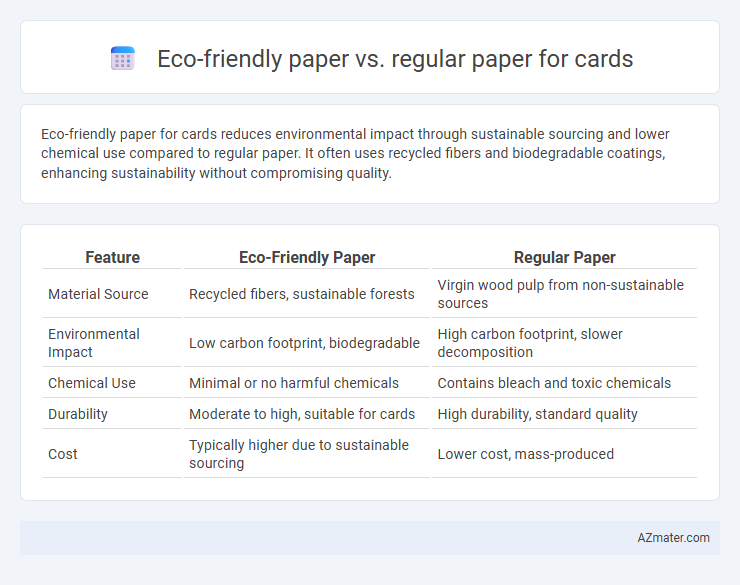Eco-friendly paper for cards reduces environmental impact through sustainable sourcing and lower chemical use compared to regular paper. It often uses recycled fibers and biodegradable coatings, enhancing sustainability without compromising quality.
Table of Comparison
| Feature | Eco-Friendly Paper | Regular Paper |
|---|---|---|
| Material Source | Recycled fibers, sustainable forests | Virgin wood pulp from non-sustainable sources |
| Environmental Impact | Low carbon footprint, biodegradable | High carbon footprint, slower decomposition |
| Chemical Use | Minimal or no harmful chemicals | Contains bleach and toxic chemicals |
| Durability | Moderate to high, suitable for cards | High durability, standard quality |
| Cost | Typically higher due to sustainable sourcing | Lower cost, mass-produced |
Introduction: The Rise of Eco-Friendly Paper for Cards
Eco-friendly paper for cards has gained significant traction due to increasing environmental awareness and consumer demand for sustainable products. Made from recycled materials or sustainably sourced fibers, eco-friendly paper reduces deforestation and carbon emissions compared to regular paper. Its adoption in card manufacturing supports eco-conscious branding while maintaining quality and durability.
What is Eco-Friendly Paper?
Eco-friendly paper is made from recycled materials or sustainably sourced fibers, reducing deforestation and minimizing environmental impact. It often uses less water, energy, and harmful chemicals during production compared to regular paper. This type of paper is biodegradable and supports sustainable forestry practices, making it an ideal choice for environmentally conscious card production.
Regular Paper: Production and Environmental Impact
Regular paper production relies heavily on virgin wood pulp, contributing to deforestation and significant energy consumption. The manufacturing process emits considerable greenhouse gases and generates wastewater containing harmful chemicals. This traditional paper's environmental footprint is exacerbated by inefficient recycling rates and landfill accumulation.
Key Differences Between Eco-Friendly and Regular Paper
Eco-friendly paper is made from recycled materials or sustainable sources like bamboo and uses less water and energy during production, reducing its environmental footprint significantly compared to regular paper. Regular paper is typically produced from virgin wood pulp, involving chemical bleaching processes that contribute to deforestation and pollution. Key differences include biodegradability, carbon footprint, and resource consumption, making eco-friendly paper a more sustainable option for cards.
How Eco-Friendly Paper Benefits the Environment
Eco-friendly paper reduces deforestation by using recycled materials and sustainable fibers, minimizing the need to harvest virgin trees. It lowers carbon emissions and water usage during production, contributing to less air and water pollution. By decomposing faster and releasing fewer toxins, eco-friendly paper supports healthier ecosystems and reduces landfill impact.
Aesthetic and Functional Qualities: Comparing Card Materials
Eco-friendly paper offers unique textures and natural tones that enhance the visual appeal of cards, providing an artisanal and organic aesthetic compared to the smooth, uniform finish of regular paper. Functionally, eco-friendly card stock tends to be thicker and more durable, promoting longevity and resistance to wear, while regular paper may prioritize cost-effectiveness and ease of printing. The choice between both materials impacts not only the tactile experience but also aligns with sustainability goals and brand values in card production.
Cost Analysis: Eco-Friendly vs Regular Paper Cards
Eco-friendly paper cards typically incur higher upfront costs due to sustainable material sourcing and specialized manufacturing processes, yet they often reduce long-term expenses through enhanced durability and recyclability. Regular paper cards offer lower initial prices but may lead to increased environmental costs and disposal fees, impacting overall budget efficiency. Businesses evaluating card production should consider lifecycle costs and environmental impact alongside immediate price differences for a comprehensive cost analysis.
Consumer Trends: Demand for Sustainable Greeting Cards
Consumer demand for sustainable greeting cards is driving a shift towards eco-friendly paper, which is made from recycled or responsibly sourced materials with lower environmental impact. Eco-friendly paper significantly reduces carbon footprint and deforestation compared to regular paper, appealing to environmentally conscious buyers. Market data shows a growing preference for biodegradable and FSC-certified cards, reflecting a strong trend in ethical consumerism within the greeting card industry.
Choosing the Right Paper: Factors for Card Makers
Eco-friendly paper offers card makers benefits such as reduced environmental impact, sustainable sourcing, and often contains recycled fibers, making it ideal for brands committed to green practices. Regular paper typically provides a smoother finish and consistent quality but may involve higher energy use and deforestation risks. Choosing the right paper depends on factors like durability, texture, cost, and environmental goals aligned with the card maker's brand values and target audience preferences.
Future Outlook: The Role of Eco-Friendly Paper in Card Industry
Eco-friendly paper is set to dominate the card industry as sustainability demands increase, driven by consumer preference for biodegradable, recycled, and tree-free materials. Innovations in production technology enhance the durability and aesthetic quality of eco-friendly paper, making it a viable alternative to traditional paper without compromising performance. Regulatory policies and corporate social responsibility initiatives will accelerate the adoption of eco-friendly paper, positioning it as a cornerstone for the future of card manufacturing.

Infographic: Eco-friendly paper vs Regular paper for Card
 azmater.com
azmater.com